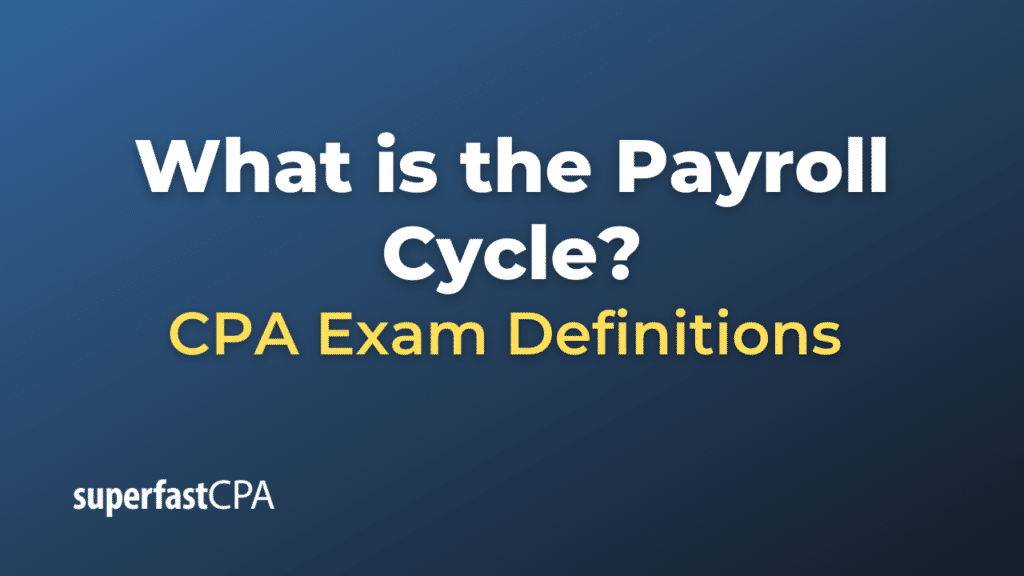Payroll Cycle
The payroll cycle, also known as the payroll process, is the series of steps that a business goes through to pay its employees. This process usually repeats on a regular schedule, such as weekly, bi-weekly, semi-monthly, or monthly, depending on the company’s pay policy.
Here are the typical steps involved in the payroll cycle:
- Collecting Timekeeping Information: The first step in the payroll process is to collect information about the number of hours each employee has worked during the pay period. This is often done through a timekeeping system where employees clock in and out.
- Verifying Timekeeping Information: The collected timekeeping information is then verified for accuracy. Managers usually review and approve their team members’ time before it is submitted for payroll processing.
- Calculating Gross Pay: Once the timekeeping information is verified, the payroll department calculates the gross pay for each employee. This is done by multiplying the number of hours worked by the employee’s hourly wage, or by calculating the pro-rata salary for the period. Any additional pay, such as bonuses or overtime, is also added to the gross pay.
- Calculating Deductions: Next, the payroll department calculates the deductions that need to be taken out of each employee’s pay. This can include income taxes, Social Security and Medicare taxes, health insurance premiums, retirement contributions, and other deductions.
- Calculating Net Pay: After all deductions are calculated, they are subtracted from the gross pay to arrive at the net pay. This is the amount that the employee will actually receive.
- Issuing Pay and Pay Statements : The payroll department then arranges for the net pay to be transferred to each employee’s bank account (for direct deposit) or issued as a check. Employees also receive a pay statement detailing their gross pay, deductions, and net pay.
- Reporting and Record Keeping : After payroll has been issued, the payroll department needs to keep records of all transactions for future reference and for reporting to tax authorities. They also need to prepare for the next payroll cycle.
This process may vary slightly depending on the company’s size, the complexity of its payroll, and the specific regulations it needs to comply with. However, the basic steps of collecting and verifying timekeeping information, calculating pay and deductions, issuing pay, and keeping records remain the same.
Example of the Payroll Cycle
Let’s take an example of a company, let’s call it “Smart Tech”, that pays its employees on a bi-weekly basis. Here is an example of how the payroll cycle might work:
- Collecting Timekeeping Information: The employees at Smart Tech use a digital timekeeping system to clock in and out each day. At the end of each two-week pay period, the system automatically generates a report of the total hours each employee worked.
- Verifying Timekeeping Information : Each department manager at Smart Tech reviews the timekeeping report for their team, checking it for accuracy and approving it. If an employee forgot to clock in or out, the manager makes the necessary corrections.
- Calculating Gross Pay: The payroll administrator at Smart Tech takes the approved timekeeping reports and calculates the gross pay for each employee. For hourly employees, this is done by multiplying their hourly rate by the number of hours they worked. For salaried employees, the payroll administrator calculates their pro-rata salary for the two-week period.
- Calculating Deductions: The payroll administrator then calculates the deductions that need to be taken out of each employee’s pay. This includes federal and state income taxes, Social Security and Medicare taxes, and contributions to health insurance or retirement plans.
- Calculating Net Pay: After calculating the deductions, the payroll administrator subtracts them from the gross pay to arrive at the net pay. This is the amount that will be paid to each employee.
- Issuing Pay and Pay Statements: The payroll administrator submits the payroll to the bank for processing. The net pay is transferred to each employee’s bank account via direct deposit. The payroll administrator also issues pay statements to each employee, either in digital or paper form, that detail their gross pay, deductions, and net pay.
- Reporting and Record Keeping: Finally, the payroll administrator keeps detailed records of the payroll for future reference and for tax reporting purposes. They also begin preparing for the next pay period.
This example illustrates a typical payroll cycle in a business. While the specific tasks and procedures might vary depending on the company and its payroll system, the basic process remains the same.














